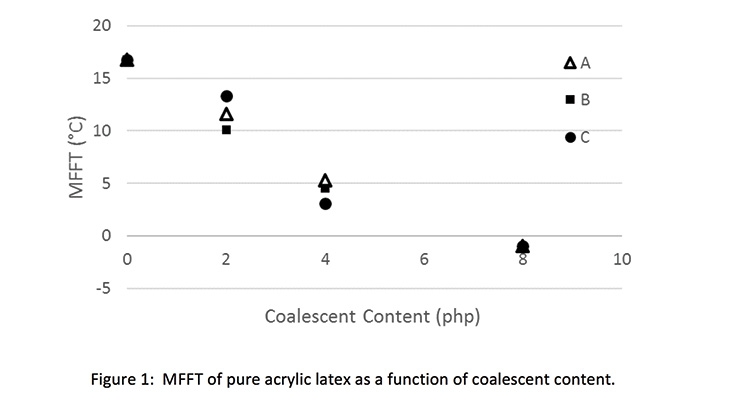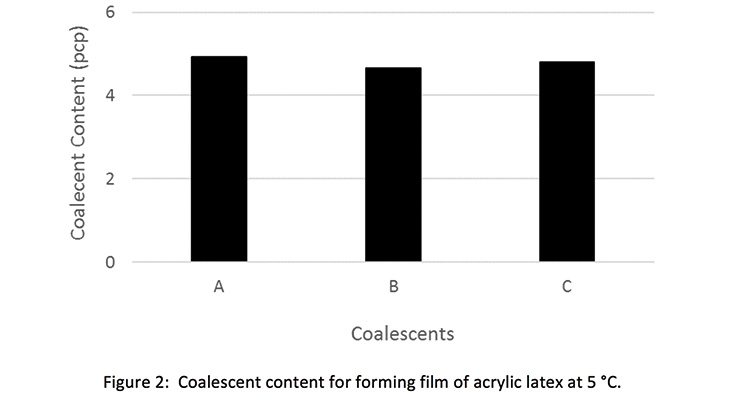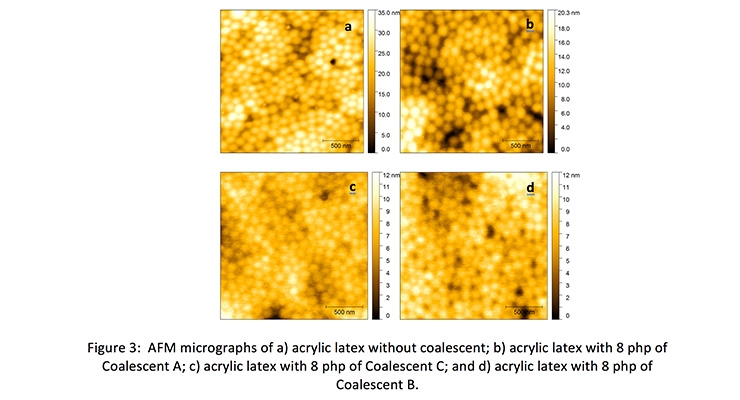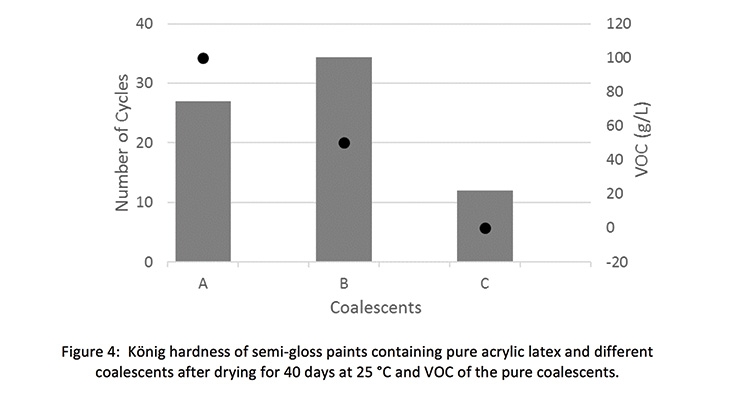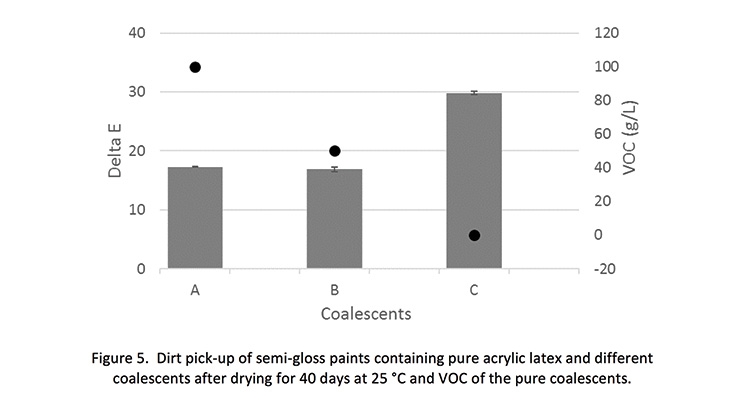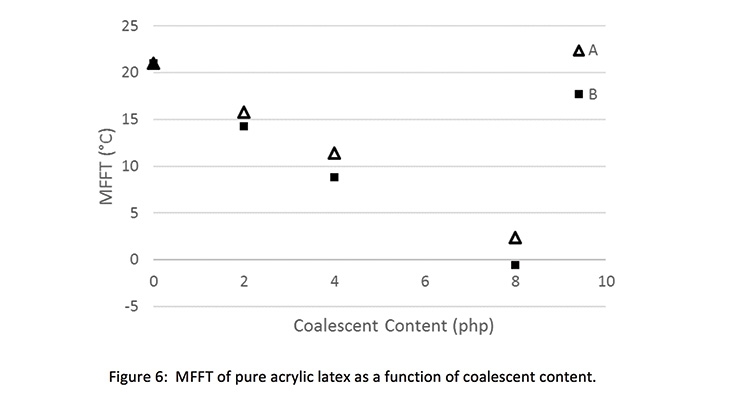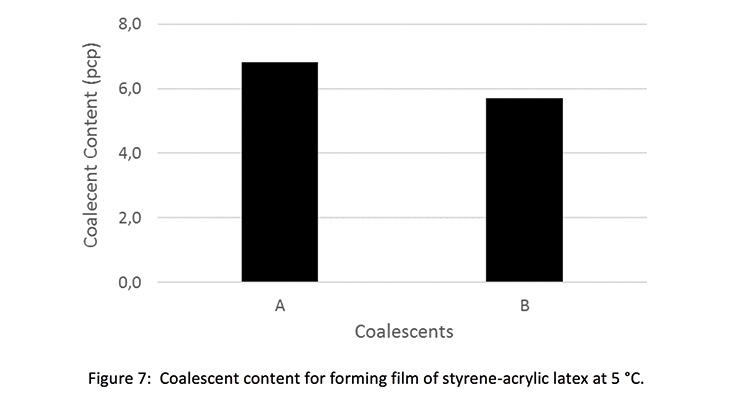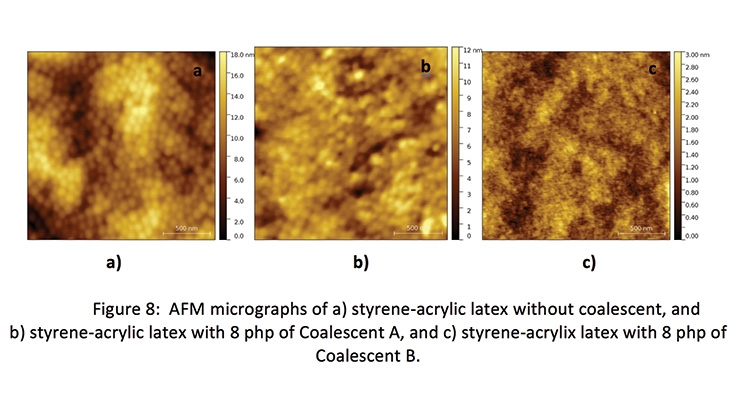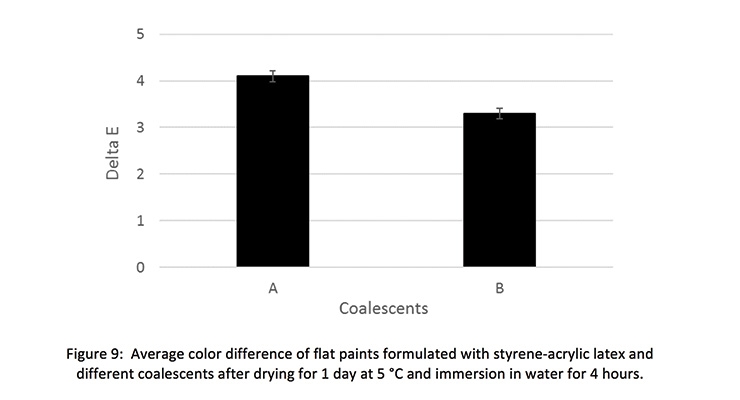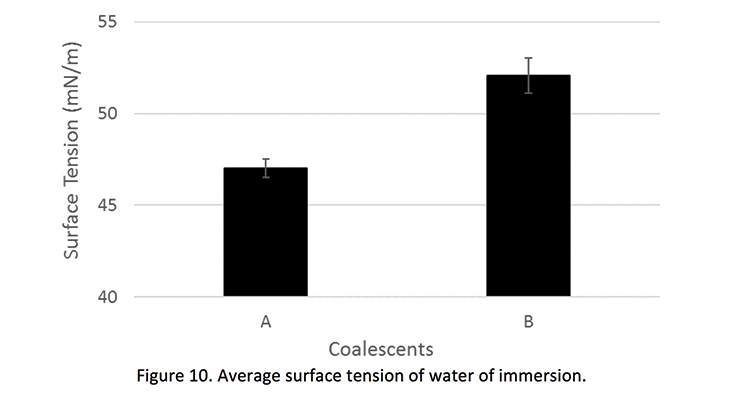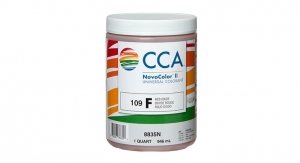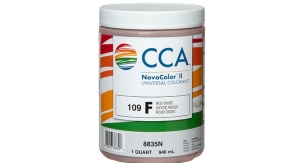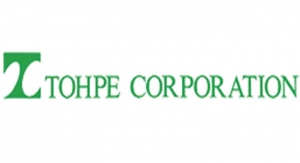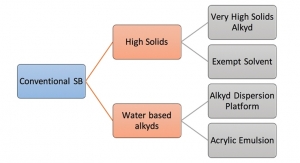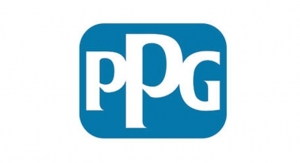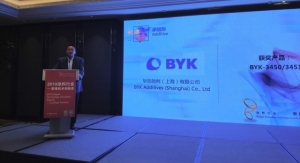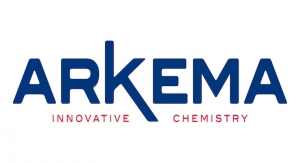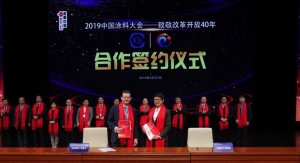Juliane P. Santos, Natália F. Paula, Robson A. Pagani, Rafael A. Caldato, Raquel da Silva and Silmar B. Barrios, Oxiteno Indústria S.A., Sao Paulo, Brazil08.09.19
Abstract
Usually, low-VOC waterborne paints generate dry paint films with lower hardness and dirt pick-up resistance due to the usage of high-boiling-point coalescents. In this work, the effect of low-VOC coalescents on latex film formation, hardness evolution, accelerated dirt pick-up resistance, and surfactant leaching of waterborne paints is explored.
AFM (atomic force microscopy) images of styrene-acrylic and pure acrylic latexes containing 4 wt% of different coalescents show that low-VOC coalescents generated films that were more coalesced and smoother than standard high-VOC coalescent. A new low-VOC coalescent generated semi-gloss paints with higher hardness evolution and better dirt pick-up resistance than commercial low-VOC coalescents and similar to standard high-VOC coalescent.
Moreover, flat paints formulated with this low-VOC coalescent dried at harsh conditions presented lower surfactant leaching in comparison to the ones formulated with standard high-VOC coalescent. These results suggest that there is a correlation between surfactant leaching and film formation assessed through AFM.
Introduction
Several properties of waterborne paints such as gloss, color, hiding power, as well as mechanical, water, wet scrub and dirt pick-up resistances depend, at least to some extent, on latex film formation. According to the literature,1,2 latex film formation is comprised of the following primary physical processes, known as stages.
Stage I: Water evaporates at a rate similar to that of pure water or a dilute solution of electrolytes, leading to the concentration, ordering, packing, and irreversible contact of
the particles.
Stage II: Water evaporation proceeds at a rate 10-20 times slower than the evaporation rate of water in Stage I, and the polymeric particles deform at temperatures higher than the MFFT (minimum film formation temperature), depending on the wet glass transition temperature (Tg) of the polymer. This allows for closer contact of the particles and the formation of continuous and transparent films.
Stage III: Polymeric chains within the particles interdiffuse across particle-particle boundaries leading to particle coalescence. This stage occurs at temperatures higher than the Tg of the dry polymer.
In applications such as architectural paints and floor finishes, durability can be decreased by using low Tg polymers; latexes with a Tg closer to, or even higher than, ambient temperature are usually preferred. To form well-coalesced films at temperatures lower than the Tg of the polymer, those latexes are blended with fugitive plasticizers (also known as coalescents). Coalescents are organic solvents that temporarily decrease the Tg of the polymers to favor the interdiffusion of polymeric chains from one particle to another.
While several scientific studies report the effect of coalescent,1-3 monomeric composition of the latex,4 particle structure,4 and drying temperature5 on film formation, there are only a few studies6 that relate some gaps in the performance of architectural waterborne paints to poor film formation. Some of these gaps may arise mainly from using MFFT measurements for optimizing the coalescent content appropriate for forming coalesced latex films, assuming that deformation and coalescence of particles occurs simultaneously. This assumption is valid mainly for latexes composed of hydrophobic polymers wherein the wet Tg and dry Tg are similar,1,2 but it is not valid for carboxylated latexes often used in architectural waterborne paints.
Techniques3 used to monitor the coalescence of latex particles include fluorescence resonance energy transfer (FRET), small angle neutron scattering (SANS), small angle X-ray scattering (SAXS), environmental scanning electron microscopy (ESEM), and atomic force microscopy (AFM). AFM is a powerful technique due to the simplicity of sample preparation and evaluation of results in comparison to the other techniques suitable for studying coalescence. AFM is also useful in studying the effect of coalescent type and content on deformation and coalescence, as well as on the morphology and flattening of latex films.
An important gap in the performance of architectural waterborne paints is caused by the use of low-VOC coalescents with high molecular weights and boiling points that do not evaporate completely from the latex films and negatively affect the hardness evolution, dirt pick-up resistance, and the overall durability of the final paints. In an AFM study of pure acrylic latex films containing low-VOC coalescents,7 the topographic images suggested that the coalescents were very effective for forming coalesced films. However, phase images showed that most of the low-VOC coalescents generated films with segregation of domains with distinct viscoelasticities suggesting that the lack of hardness evolution in those films can be related to the heterogeneous distribution of polymeric domains plasticized with coalescents along the film.
Another important gap in the performance of architectural waterborne paints, especially deep colored ones, is the leaching of water-soluble species, commonly known as surfactant leaching, which occurs when paints are submitted to high humidity or rain before being completely coalesced. During leaching, water may preferably diffuse through the channels of the dry paints extracting the water-soluble species.
Some potential reasons for surfactant leaching to occur are the concentration of voids in the dry paints that increases with pigment volume concentration (PVC), quality of latex film formation, presence of hydrophilic channels for water diffusion, and excess of water-soluble species and their distribution in the dry paints. Vanderhoff et al.8 showed that films containing deformed particles of a hydrophobic latex of vinylidene chloride-butyl acrylate that were stabilized by an anionic comonomer presented water vapor permeability rates much higher than the coalesced films. These results suggest that latex films containing deformed particles have hydrophilic channels wherein water diffuses, and as soon as those particles coalesce, the water vapor permeability rate decreases to values similar to that of the pure polymers.
These results show the importance of film formation on problems caused by water diffusion such as surfactant leaching.
In this paper, the effect of a new low-VOC coalescent on film formation assessed through AFM, dirt pick-up resistance of semi-gloss paints, and leaching of flat paints
is presented.
Experimental
Materials and Methods
Latex
Commercial styrene-acrylic and pure acrylic latexes with MFFT of 17 and 21 °C, respectively, were used in the MFFT and AFM evaluations as well as in the semi-gloss and flat paint formulations.
Coalescents
The coalescents evaluated in this study are presented in Table 1.
VOC Content
VOC content within the coalescents was determined according to EPA Method 24.
Boiling Temperature
The boiling temperature analyses were perfomed according to NBR 9292.
MFFT (Minimum Film Formation Temperature)
The minimum film formation temperature evaluations of the latexes containing different coalescents were performed according to ASTM D2354, using a Rhopoint-MFFT 60.
Preparation of Films for AFM Evaluation
Latexes containing 8 php (parts per hundred of polymer) or 4 wt% of different coalescents were cast on Leneta Scrub Test Panels and dried for 7 days at 25 °C and 60% RH before AFM evaluations.
Atomic Force Microscopy
AFM images were obtained using a commercial setup (NX-10, Park Systems, Korea). The microscope was operated in intermittent contact mode slightly below the frequency of resonance, in nitrogen and at ambient temperature, using NCLR (Nano sensors) Si probes with spring constant of 48 N/m and resonance frequency within 190 kHz. Topographic and phase images were recorded, and the images were analyzed and processed via Gwyddion software.
Paints
The coatings evaluated in this work were semi-gloss paints with PVC of 30% and flat paints with PVC of about 55% containing 2% of a blue pigment.
Hardness
Hardness evolution of the paint films was performed according to ASTM D4366 using a König Pendulum Hardness tester from BYK Gardner.
Dirt Pick-up Resistance
Dirt pick-up resistance of the paints was evaluated using an internal methodology under development. The semi-gloss paints were cast at a thickness of 150 µm on Leneta Scrub Test Panels and dried for seven days at 25 °C and 60% RH. Next, a 20 µm thick film of standard dirt was cast on half of the painted area and dried for 24 hours at 25 °C and 60% RH. Dirt removal was standardized by applying four cycles of cleaning using tap water, a pad, and a Wet Abrasion Scrub Tester containing a pad holder. The chart was then cleaned with tap water, lifted to a vertical position, and dried for three days at 25 °C and 60% RH. The color difference between the area that receive the dirt and the area that did not received the dirt was measured using a BYK Color Spectrophotometer. The greater the difference in color between these two areas of the paint, the lower is the dirt pick-up resistance.
Leaching Resistance
Leaching resistance of the deep-colored flat paints was measured using an internal methodology under development. Flat paints were cast at a thickness of 400 µm on Leneta Scrub Test Panels and dried for 24 hours at 5 °C. The color of the dry coatings was measured, and the panels were cut into 2 x 2 inches squares before immersion in 20 mL of deionized water with surface tension of 72 mN/m for 4 hours. The panels, after being removed from water, were dried for 7 days at 25 °C and 60% RH, their color was measured, and the surface tension of the water of immersion was checked. The greater the difference in color before and after immersion in water, the higher is the leaching of surfactant and lower is the leaching resistance.
Results and Discussion
As mentioned above, the coalescents investigated in this work have different VOC contents and the main goal of this work is to show their effect on film formation and on performance properties relevant for exterior paints. These results are presented presented in two sections.
The first section discusses the effect of coalescents with different VOC content on film formation of the pure acrylic latex, on hardness evolution and dirt pick-up resistance of semi-gloss paints.
The second section discusses the effect of coalescents with different VOC contents and similar dirt pick-up resistance on film formation of the styrene-acrylic latex and on surfactant leaching of flat paints.
Effect of Coalescent with Different VOC Contents on Film Formation and Dirt Pick-up Resistance
The influence of the three coalescents on the MFFT of the acrylic latex (MFFT 17 °C) is shown in Figure 1. For all coalescent contents, the three coalescents interacted very well with the polymeric particles assisting in particle deformation, and formation of continuous and transparent films.
The coalescent content required for forming films at 5 °C (Figure 2) confirms that the three coalescents have similar efficiency for decreasing the MFFT of the acrylic latex.
As said previously, the MFFT data can only predict that the particles within the films are at least deformed but it can not predict the level of coalescence of those particles. Hence, the films were analyzed via AFM and the images are presented in Figure 3.
Figure 3a shows the topographic image of the pure latex (MFFT 17 °C) dried at 25 °C for 7 days. In this image, it is possible to identify the domains of the deformed particles and the maximum diference in height observed in this film is 35 nm. Thus, even upon drying the latex at a temperature above its MFFT, the polymeric chains did not have enough energy for diffusing across particles boundaries and forming a coalesced film.
Figures 3b, 3c and 3d are topographic images of the acrylic latex containing 8 php of Coalescent A, Coalescent C and Coalescent B, respectively. Coalescent A is the benchmark 100% VOC coalescent in the market, and the latex film containing 8 php of this coalescent (Figure 3b) is smoother than the one without coalescent (Figure 3a). However, it is still possible to identify the particle domains suggesting that the particles within the film are not completelly coalesced.
Figure 3c presents the topographic image of the acrylic latex film containing 8 php of Coalescent C, which is the benchmark zero VOC coalescent in the market. The particles in this film are more deformed, their domains are less visible, and the film is smoother than the film containing Coalescent A.
Figure 3d presents the topographic image of the acrylic latex film containing 8 php of Coalescent B, which is the low-VOC coalescent under development at Oxiteno. The particle domains in this film are less visible than in the film containing Coalescent A and present a topographic pattern similar to that with coalescent C. Based on the AFM data of Figure 3, acrylic latex films containing Coalescent B and Coalescent C are smoother and more coalesced than the one containing Coalescent A. This trend was previously reported by Juhué et al.9 and it suggests that coalescents with a high affinity to the polymeric particles and a low evaporation rate form films more coalesced than coalescents with a higher evaporation rate because the local concentration of the former coalescents in the polymeric particles is higher during the film formation.
As mentioned previously, the main disadvantage of using zero VOC coalescents is their negative impact on hardness evolution and dirt pick-up resistance of the final paints. This negative impact can be seen in Figures 4 and 5. In both Figures, the zero VOC coalescent, Coalescent C, generated semi-gloss paints with low values of König hardness and low dirt pick-up resistance, even for paints dried for 40 days at 25 °C before being evaluated. On the other hand, Coalescent B, that has an intermediate level of VOC, presented the same level of hardness evolution and dirt pick-up resistance as Coalescent A (100 % VOC coalescent).
The results of this section suggest that Coalescent C has the advantages of being zero VOC and more efficient in assisting coalescence than Coalescent A. However, it has the disadvantages of generating paints with poor hardness evolution and dirt pick-up resistance. Coalescent B has the advantages of having 50% of the VOC of Coalescent A, being more efficient in assisting coalescence, and similar hardness evolution and dirt pick-up resistance as Coalescent A. As a result, Coalescent B is more recommended for exterior paints than Coalescent C.
Effect of Coalescent with Similar Dirt Pick-up Resistance on Film Formation and Surfactant Leaching
This section discusses Coalescent A and Coalescent B, which are suitable for being used in exterior paints because of their ability to yield semi-gloss paints with high dirt pick-up resistance.
Special attention is given to the effect of these coalescents on film formation of a styrene-acrylic latex assessed through MFFT and AFM, and on leaching of flat paints assessed through a methodology under development at Oxiteno.
The ability of these coalescents to decrease the MFFT of a styrene-acrylic latex with MFFT of 21 °C is presented in Figure 6. At all coalescent levels, Coalescent B lowered the MFFT more than Coalescent A. Hence, the amount of Coalescent B required to decrease the MFFT of the styrene-acrylic latex to 5 °C is about 20 wt% lower than Coalescent A (Figure 7).
These MFFT data suggest that Coalescent B has more affinity to the styrene-acrylic latex than Coalescent A, forming transparent films with deformed particles at a lower coalescent content. AFM micrographs of the styrene-acrylic latex without coalescent and with 8 php of Coalescent A and Coalescent B are shown in Figure 8. Figure 8a shows that particle domains are visible in the film of the pure latex even after being dried at 25 °C for 7 days.
Figure 8b shows that in the presence of Coalescent A, the particle domains within the styrene-acrylic latex film are less visible and the film is smoother than in Figure 8a, but the particles are still visible suggesting incomplete coalescence of the latex particles. Figure 8c shows that the film of the styrene-acrylic latex containing Coalescent B is completely coalesced and very smooth, with the maximum difference in height in this area of the film being only 3 nm. These AFM data suggest that Coalescent B is more efficient for generating coalesced particles than Coalescent A.
As mentioned previously, film formation is one of the factors that may affect the leaching of surfactants in external paints mainly because the diffusion of water through a coalesced film is slower than the diffusion of water through the hydrophilic channels of a film containing deformed particles.
The leaching methodology involved the drying of deep-color flat paints formulated with coalescents A and B, for 24 h at 5 °C, followed by color measurement. The panels were then immersed in water (surface tension 72 mN/m) for 4 hours. Upon removal from water, the panels were dried for 7 days at 25 °C and their color was measured again. The average color differences of these coatings before and after immersion in water are presented in Figure 9. The greater the color difference, the higher is the leaching. Based on these results, the flat paints containing Coalescent A leached more than the flat paints containing Coalescent B.
The surface tension data of Figure 10 also agreed with the leaching trend observed in Figure 9 since the flat paint that presented the higher color difference, i.e., greater leaching, also resulted in the immersion water with the lowest surface tension.
Those data suggest that a coalescent that is more efficient for assisting film formation, especially the coalescence of latex particles, can improve the leaching resistance of paints.
Conclusions
Topographic images confirmed the trend that zero- to low-VOC coalescents are more efficient for generating coalesced films than the high-VOC coalescent evaluated in this work. As the use of zero-VOC coalescent has the drawback of generating paints with poor dirt pick-up resistance, the use of low-VOC coalescents seems to be an interesting alternative because it gathers the film formation efficiency and low-VOC content allowing the development of exterior paints with low VOC.
Moreover, the new low-VOC coalescent due to its high efficiency for forming coalesced films seems to have a positive impact on leaching resistance of external coatings. Consequently, the use of this coalescent as well as latexes containing copolymerizable surfactants can be a path for developing external coatings with better water resistance in the future.
Future Work
Further work on dirt pick-up and leaching methodologies are going on to optimize them following the needs of the market and validate their repeatability and reproducibility using commercial colored paints. Further evaluations will be performed to correlate the features of film formation obtained from AFM with paint properties and apply this knowledge for developing paint formulations with optimum technical and environmental performances.
Acknowledgments
Acknowledgments for the National Center of Research in Energy and Materials (CNPEM) for performing the AFM analyses.
References
1) J. L. Keddie, Film Formation of Latex, Materials Science and Engineering R: Reports 1997, 21(3), 101 - 170.
2) P. A. Steward, J. Hearna and M. C. Wilkinson, An Overview of Polymer Latex Film Formation and Properties, Advances in Colloid and Interface Science, 2000, 86, 195 - 267.
3) J. L. Keddie and A. F. Routh, Fundamentals of Latex Film Formation: Processes and Properties, Canopus Academic Publishing Limited, Bristol, 2010.
4) Y. Chevalier, C. Pichot, C. Graillat, M. Joanicot, K. Wong, J. Maquet, P. Lindner and B. Cabane, Film Formation with Latex Particles, Colloid Polymer Science, 1992, 270(8), 806 - 821.
5) E. Perez and J. Lang, Flattening of Latex Film Surface and Polymer Chain Diffusion, Langmuir 2000, 16, 1874 - 1881.
6) R. Matranga, B. Doran, A. Fream, C. Baude, E. Bousseau and M. Secher, Early Rain Resistance and Surfactant Leaching Resistant Binder, American Coating Show 2018.
7) J. P. Santos, R. A. Pagani, C. R. Tomassini, R. C. J. P. Silva, K. Sharp and S. B. Barrios, Atomic Force Microscopy Study: Effect of Low VOC Coalescents on Morphology and Phase Distribution of Latex Films, Paints & Coatings Industry, June 2017.
8) J. W. Vanderhoff, E. B. Bradford and W. K. Carrington, The Transport of Water through Latex Films, Journal of Polymer Science, 1973, 41, 155 - 174.
9) D. Juhué, Y. C. Wang, J. Lang, O. M. Leung, M. C. Goh and M. A. Winnik, Surfactant Exudation in the Presence of a Coalescing Aid in Latex Film Studied by Atomic-Force Microscopy, Journal of Polymer Science Part B, 1995, 33(7), 1123 - 1133.
Usually, low-VOC waterborne paints generate dry paint films with lower hardness and dirt pick-up resistance due to the usage of high-boiling-point coalescents. In this work, the effect of low-VOC coalescents on latex film formation, hardness evolution, accelerated dirt pick-up resistance, and surfactant leaching of waterborne paints is explored.
AFM (atomic force microscopy) images of styrene-acrylic and pure acrylic latexes containing 4 wt% of different coalescents show that low-VOC coalescents generated films that were more coalesced and smoother than standard high-VOC coalescent. A new low-VOC coalescent generated semi-gloss paints with higher hardness evolution and better dirt pick-up resistance than commercial low-VOC coalescents and similar to standard high-VOC coalescent.
Moreover, flat paints formulated with this low-VOC coalescent dried at harsh conditions presented lower surfactant leaching in comparison to the ones formulated with standard high-VOC coalescent. These results suggest that there is a correlation between surfactant leaching and film formation assessed through AFM.
Introduction
Several properties of waterborne paints such as gloss, color, hiding power, as well as mechanical, water, wet scrub and dirt pick-up resistances depend, at least to some extent, on latex film formation. According to the literature,1,2 latex film formation is comprised of the following primary physical processes, known as stages.
Stage I: Water evaporates at a rate similar to that of pure water or a dilute solution of electrolytes, leading to the concentration, ordering, packing, and irreversible contact of
the particles.
Stage II: Water evaporation proceeds at a rate 10-20 times slower than the evaporation rate of water in Stage I, and the polymeric particles deform at temperatures higher than the MFFT (minimum film formation temperature), depending on the wet glass transition temperature (Tg) of the polymer. This allows for closer contact of the particles and the formation of continuous and transparent films.
Stage III: Polymeric chains within the particles interdiffuse across particle-particle boundaries leading to particle coalescence. This stage occurs at temperatures higher than the Tg of the dry polymer.
In applications such as architectural paints and floor finishes, durability can be decreased by using low Tg polymers; latexes with a Tg closer to, or even higher than, ambient temperature are usually preferred. To form well-coalesced films at temperatures lower than the Tg of the polymer, those latexes are blended with fugitive plasticizers (also known as coalescents). Coalescents are organic solvents that temporarily decrease the Tg of the polymers to favor the interdiffusion of polymeric chains from one particle to another.
While several scientific studies report the effect of coalescent,1-3 monomeric composition of the latex,4 particle structure,4 and drying temperature5 on film formation, there are only a few studies6 that relate some gaps in the performance of architectural waterborne paints to poor film formation. Some of these gaps may arise mainly from using MFFT measurements for optimizing the coalescent content appropriate for forming coalesced latex films, assuming that deformation and coalescence of particles occurs simultaneously. This assumption is valid mainly for latexes composed of hydrophobic polymers wherein the wet Tg and dry Tg are similar,1,2 but it is not valid for carboxylated latexes often used in architectural waterborne paints.
Techniques3 used to monitor the coalescence of latex particles include fluorescence resonance energy transfer (FRET), small angle neutron scattering (SANS), small angle X-ray scattering (SAXS), environmental scanning electron microscopy (ESEM), and atomic force microscopy (AFM). AFM is a powerful technique due to the simplicity of sample preparation and evaluation of results in comparison to the other techniques suitable for studying coalescence. AFM is also useful in studying the effect of coalescent type and content on deformation and coalescence, as well as on the morphology and flattening of latex films.
An important gap in the performance of architectural waterborne paints is caused by the use of low-VOC coalescents with high molecular weights and boiling points that do not evaporate completely from the latex films and negatively affect the hardness evolution, dirt pick-up resistance, and the overall durability of the final paints. In an AFM study of pure acrylic latex films containing low-VOC coalescents,7 the topographic images suggested that the coalescents were very effective for forming coalesced films. However, phase images showed that most of the low-VOC coalescents generated films with segregation of domains with distinct viscoelasticities suggesting that the lack of hardness evolution in those films can be related to the heterogeneous distribution of polymeric domains plasticized with coalescents along the film.
Another important gap in the performance of architectural waterborne paints, especially deep colored ones, is the leaching of water-soluble species, commonly known as surfactant leaching, which occurs when paints are submitted to high humidity or rain before being completely coalesced. During leaching, water may preferably diffuse through the channels of the dry paints extracting the water-soluble species.
Some potential reasons for surfactant leaching to occur are the concentration of voids in the dry paints that increases with pigment volume concentration (PVC), quality of latex film formation, presence of hydrophilic channels for water diffusion, and excess of water-soluble species and their distribution in the dry paints. Vanderhoff et al.8 showed that films containing deformed particles of a hydrophobic latex of vinylidene chloride-butyl acrylate that were stabilized by an anionic comonomer presented water vapor permeability rates much higher than the coalesced films. These results suggest that latex films containing deformed particles have hydrophilic channels wherein water diffuses, and as soon as those particles coalesce, the water vapor permeability rate decreases to values similar to that of the pure polymers.
These results show the importance of film formation on problems caused by water diffusion such as surfactant leaching.
In this paper, the effect of a new low-VOC coalescent on film formation assessed through AFM, dirt pick-up resistance of semi-gloss paints, and leaching of flat paints
is presented.
Experimental
Materials and Methods
Latex
Commercial styrene-acrylic and pure acrylic latexes with MFFT of 17 and 21 °C, respectively, were used in the MFFT and AFM evaluations as well as in the semi-gloss and flat paint formulations.
Coalescents
The coalescents evaluated in this study are presented in Table 1.
VOC Content
VOC content within the coalescents was determined according to EPA Method 24.
Boiling Temperature
The boiling temperature analyses were perfomed according to NBR 9292.
MFFT (Minimum Film Formation Temperature)
The minimum film formation temperature evaluations of the latexes containing different coalescents were performed according to ASTM D2354, using a Rhopoint-MFFT 60.
Preparation of Films for AFM Evaluation
Latexes containing 8 php (parts per hundred of polymer) or 4 wt% of different coalescents were cast on Leneta Scrub Test Panels and dried for 7 days at 25 °C and 60% RH before AFM evaluations.
Atomic Force Microscopy
AFM images were obtained using a commercial setup (NX-10, Park Systems, Korea). The microscope was operated in intermittent contact mode slightly below the frequency of resonance, in nitrogen and at ambient temperature, using NCLR (Nano sensors) Si probes with spring constant of 48 N/m and resonance frequency within 190 kHz. Topographic and phase images were recorded, and the images were analyzed and processed via Gwyddion software.
Paints
The coatings evaluated in this work were semi-gloss paints with PVC of 30% and flat paints with PVC of about 55% containing 2% of a blue pigment.
Hardness
Hardness evolution of the paint films was performed according to ASTM D4366 using a König Pendulum Hardness tester from BYK Gardner.
Dirt Pick-up Resistance
Dirt pick-up resistance of the paints was evaluated using an internal methodology under development. The semi-gloss paints were cast at a thickness of 150 µm on Leneta Scrub Test Panels and dried for seven days at 25 °C and 60% RH. Next, a 20 µm thick film of standard dirt was cast on half of the painted area and dried for 24 hours at 25 °C and 60% RH. Dirt removal was standardized by applying four cycles of cleaning using tap water, a pad, and a Wet Abrasion Scrub Tester containing a pad holder. The chart was then cleaned with tap water, lifted to a vertical position, and dried for three days at 25 °C and 60% RH. The color difference between the area that receive the dirt and the area that did not received the dirt was measured using a BYK Color Spectrophotometer. The greater the difference in color between these two areas of the paint, the lower is the dirt pick-up resistance.
Leaching Resistance
Leaching resistance of the deep-colored flat paints was measured using an internal methodology under development. Flat paints were cast at a thickness of 400 µm on Leneta Scrub Test Panels and dried for 24 hours at 5 °C. The color of the dry coatings was measured, and the panels were cut into 2 x 2 inches squares before immersion in 20 mL of deionized water with surface tension of 72 mN/m for 4 hours. The panels, after being removed from water, were dried for 7 days at 25 °C and 60% RH, their color was measured, and the surface tension of the water of immersion was checked. The greater the difference in color before and after immersion in water, the higher is the leaching of surfactant and lower is the leaching resistance.
Results and Discussion
As mentioned above, the coalescents investigated in this work have different VOC contents and the main goal of this work is to show their effect on film formation and on performance properties relevant for exterior paints. These results are presented presented in two sections.
The first section discusses the effect of coalescents with different VOC content on film formation of the pure acrylic latex, on hardness evolution and dirt pick-up resistance of semi-gloss paints.
The second section discusses the effect of coalescents with different VOC contents and similar dirt pick-up resistance on film formation of the styrene-acrylic latex and on surfactant leaching of flat paints.
Effect of Coalescent with Different VOC Contents on Film Formation and Dirt Pick-up Resistance
The influence of the three coalescents on the MFFT of the acrylic latex (MFFT 17 °C) is shown in Figure 1. For all coalescent contents, the three coalescents interacted very well with the polymeric particles assisting in particle deformation, and formation of continuous and transparent films.
The coalescent content required for forming films at 5 °C (Figure 2) confirms that the three coalescents have similar efficiency for decreasing the MFFT of the acrylic latex.
As said previously, the MFFT data can only predict that the particles within the films are at least deformed but it can not predict the level of coalescence of those particles. Hence, the films were analyzed via AFM and the images are presented in Figure 3.
Figure 3a shows the topographic image of the pure latex (MFFT 17 °C) dried at 25 °C for 7 days. In this image, it is possible to identify the domains of the deformed particles and the maximum diference in height observed in this film is 35 nm. Thus, even upon drying the latex at a temperature above its MFFT, the polymeric chains did not have enough energy for diffusing across particles boundaries and forming a coalesced film.
Figures 3b, 3c and 3d are topographic images of the acrylic latex containing 8 php of Coalescent A, Coalescent C and Coalescent B, respectively. Coalescent A is the benchmark 100% VOC coalescent in the market, and the latex film containing 8 php of this coalescent (Figure 3b) is smoother than the one without coalescent (Figure 3a). However, it is still possible to identify the particle domains suggesting that the particles within the film are not completelly coalesced.
Figure 3c presents the topographic image of the acrylic latex film containing 8 php of Coalescent C, which is the benchmark zero VOC coalescent in the market. The particles in this film are more deformed, their domains are less visible, and the film is smoother than the film containing Coalescent A.
Figure 3d presents the topographic image of the acrylic latex film containing 8 php of Coalescent B, which is the low-VOC coalescent under development at Oxiteno. The particle domains in this film are less visible than in the film containing Coalescent A and present a topographic pattern similar to that with coalescent C. Based on the AFM data of Figure 3, acrylic latex films containing Coalescent B and Coalescent C are smoother and more coalesced than the one containing Coalescent A. This trend was previously reported by Juhué et al.9 and it suggests that coalescents with a high affinity to the polymeric particles and a low evaporation rate form films more coalesced than coalescents with a higher evaporation rate because the local concentration of the former coalescents in the polymeric particles is higher during the film formation.
As mentioned previously, the main disadvantage of using zero VOC coalescents is their negative impact on hardness evolution and dirt pick-up resistance of the final paints. This negative impact can be seen in Figures 4 and 5. In both Figures, the zero VOC coalescent, Coalescent C, generated semi-gloss paints with low values of König hardness and low dirt pick-up resistance, even for paints dried for 40 days at 25 °C before being evaluated. On the other hand, Coalescent B, that has an intermediate level of VOC, presented the same level of hardness evolution and dirt pick-up resistance as Coalescent A (100 % VOC coalescent).
The results of this section suggest that Coalescent C has the advantages of being zero VOC and more efficient in assisting coalescence than Coalescent A. However, it has the disadvantages of generating paints with poor hardness evolution and dirt pick-up resistance. Coalescent B has the advantages of having 50% of the VOC of Coalescent A, being more efficient in assisting coalescence, and similar hardness evolution and dirt pick-up resistance as Coalescent A. As a result, Coalescent B is more recommended for exterior paints than Coalescent C.
Effect of Coalescent with Similar Dirt Pick-up Resistance on Film Formation and Surfactant Leaching
This section discusses Coalescent A and Coalescent B, which are suitable for being used in exterior paints because of their ability to yield semi-gloss paints with high dirt pick-up resistance.
Special attention is given to the effect of these coalescents on film formation of a styrene-acrylic latex assessed through MFFT and AFM, and on leaching of flat paints assessed through a methodology under development at Oxiteno.
The ability of these coalescents to decrease the MFFT of a styrene-acrylic latex with MFFT of 21 °C is presented in Figure 6. At all coalescent levels, Coalescent B lowered the MFFT more than Coalescent A. Hence, the amount of Coalescent B required to decrease the MFFT of the styrene-acrylic latex to 5 °C is about 20 wt% lower than Coalescent A (Figure 7).
These MFFT data suggest that Coalescent B has more affinity to the styrene-acrylic latex than Coalescent A, forming transparent films with deformed particles at a lower coalescent content. AFM micrographs of the styrene-acrylic latex without coalescent and with 8 php of Coalescent A and Coalescent B are shown in Figure 8. Figure 8a shows that particle domains are visible in the film of the pure latex even after being dried at 25 °C for 7 days.
Figure 8b shows that in the presence of Coalescent A, the particle domains within the styrene-acrylic latex film are less visible and the film is smoother than in Figure 8a, but the particles are still visible suggesting incomplete coalescence of the latex particles. Figure 8c shows that the film of the styrene-acrylic latex containing Coalescent B is completely coalesced and very smooth, with the maximum difference in height in this area of the film being only 3 nm. These AFM data suggest that Coalescent B is more efficient for generating coalesced particles than Coalescent A.
As mentioned previously, film formation is one of the factors that may affect the leaching of surfactants in external paints mainly because the diffusion of water through a coalesced film is slower than the diffusion of water through the hydrophilic channels of a film containing deformed particles.
The leaching methodology involved the drying of deep-color flat paints formulated with coalescents A and B, for 24 h at 5 °C, followed by color measurement. The panels were then immersed in water (surface tension 72 mN/m) for 4 hours. Upon removal from water, the panels were dried for 7 days at 25 °C and their color was measured again. The average color differences of these coatings before and after immersion in water are presented in Figure 9. The greater the color difference, the higher is the leaching. Based on these results, the flat paints containing Coalescent A leached more than the flat paints containing Coalescent B.
The surface tension data of Figure 10 also agreed with the leaching trend observed in Figure 9 since the flat paint that presented the higher color difference, i.e., greater leaching, also resulted in the immersion water with the lowest surface tension.
Those data suggest that a coalescent that is more efficient for assisting film formation, especially the coalescence of latex particles, can improve the leaching resistance of paints.
Conclusions
Topographic images confirmed the trend that zero- to low-VOC coalescents are more efficient for generating coalesced films than the high-VOC coalescent evaluated in this work. As the use of zero-VOC coalescent has the drawback of generating paints with poor dirt pick-up resistance, the use of low-VOC coalescents seems to be an interesting alternative because it gathers the film formation efficiency and low-VOC content allowing the development of exterior paints with low VOC.
Moreover, the new low-VOC coalescent due to its high efficiency for forming coalesced films seems to have a positive impact on leaching resistance of external coatings. Consequently, the use of this coalescent as well as latexes containing copolymerizable surfactants can be a path for developing external coatings with better water resistance in the future.
Future Work
Further work on dirt pick-up and leaching methodologies are going on to optimize them following the needs of the market and validate their repeatability and reproducibility using commercial colored paints. Further evaluations will be performed to correlate the features of film formation obtained from AFM with paint properties and apply this knowledge for developing paint formulations with optimum technical and environmental performances.
Acknowledgments
Acknowledgments for the National Center of Research in Energy and Materials (CNPEM) for performing the AFM analyses.
References
1) J. L. Keddie, Film Formation of Latex, Materials Science and Engineering R: Reports 1997, 21(3), 101 - 170.
2) P. A. Steward, J. Hearna and M. C. Wilkinson, An Overview of Polymer Latex Film Formation and Properties, Advances in Colloid and Interface Science, 2000, 86, 195 - 267.
3) J. L. Keddie and A. F. Routh, Fundamentals of Latex Film Formation: Processes and Properties, Canopus Academic Publishing Limited, Bristol, 2010.
4) Y. Chevalier, C. Pichot, C. Graillat, M. Joanicot, K. Wong, J. Maquet, P. Lindner and B. Cabane, Film Formation with Latex Particles, Colloid Polymer Science, 1992, 270(8), 806 - 821.
5) E. Perez and J. Lang, Flattening of Latex Film Surface and Polymer Chain Diffusion, Langmuir 2000, 16, 1874 - 1881.
6) R. Matranga, B. Doran, A. Fream, C. Baude, E. Bousseau and M. Secher, Early Rain Resistance and Surfactant Leaching Resistant Binder, American Coating Show 2018.
7) J. P. Santos, R. A. Pagani, C. R. Tomassini, R. C. J. P. Silva, K. Sharp and S. B. Barrios, Atomic Force Microscopy Study: Effect of Low VOC Coalescents on Morphology and Phase Distribution of Latex Films, Paints & Coatings Industry, June 2017.
8) J. W. Vanderhoff, E. B. Bradford and W. K. Carrington, The Transport of Water through Latex Films, Journal of Polymer Science, 1973, 41, 155 - 174.
9) D. Juhué, Y. C. Wang, J. Lang, O. M. Leung, M. C. Goh and M. A. Winnik, Surfactant Exudation in the Presence of a Coalescing Aid in Latex Film Studied by Atomic-Force Microscopy, Journal of Polymer Science Part B, 1995, 33(7), 1123 - 1133.


